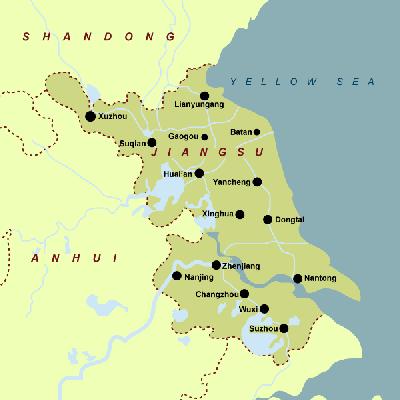| Map |
|
|
Jiangsu
Situated in the climatic transition zone of warm-temperate and sub-tropical zones, Jiangsu has mild weather, moderate rainfall and clear-cut seasonal changes. The climate differs between north and south: The mean annual temperature is 13-16oC, increasing from north to south, while the mean annual precipitation is 800-1,200 mm. There are frequent "plum rains" between spring and summer, and typhoon rains between late summer and early autumn.
It is divided into 13 prefecture-level cities, 31 county-level cities and 33 counties, with a population of 74.38 million as of 2000. It is one of the most densely populated provinces.
Jiangsu specialties include West Lake fish, Nanjing Salted Duck, Lake Tai Whitebait and Beggar's Chicken (the chicken is baked in lotus leaves and clay).
Suzhou Pingtan (a kind of opera), ditty, etc
The special local products are Suzhou embroidery, Yixing pottery, Yangzhou lacquer ware, Wuxi clay figurine, Nanjing Yuhua Stone (rain flower pebbles), etc.
Jiangsu Province, Su for short, lies in East China. The industries and the agriculture here are well developed. Among its agricultural produces, the outputs of rice, cotton, silk, tea, oil and freshwater fish hold important positions in China. Its most important industries are machinery, chemical industry, electricity, electronics and cement. Known as a "land of fish and rice", Jiangsu gets its name from the first character of its two cities, Jiangning (now Nanjing) and Suzhou.
Jiangsu boasts the largest number of historical and cultural cities, such as Worldly Heaven Suzhou, Yangzhou, Nanjing, Zhenjiang, Huai'an, and Xuzhou, etc. Of the more than 200 lakes, the larger ones are the Hongze Lake, the West Lake, the Tai Lake, the Xuanwu Lake, and the Gaoyou Lake, which earn Jiangsu the name "Water Countryside". Historical relics include the Stone City in Nanjing, Dr. Sun Yat-sen's Tomb, the Xiao Tomb of the Ming Dynasty (1368-1644), Han Mausoleum and Pits of Terracotta Soldiers, etc. Other places of interest are Yuntai Mountain, Zhongshan Mountain, the Suzhou Garden and the Three Caves in Yixing. |
||||
 |
 Geography
Geography
 Climate
Climate Administrative Division and
Population
Administrative Division and
Population Food
Food  Culture
Culture  Special Local Products
Special Local Products Brief Introduction
Brief Introduction